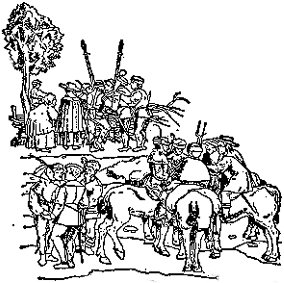
http://www.luminarium.org/encyclopedia/jackcade.htm
JOHN CADE, commonly called Jack Cade, English rebel and leader of the rising of 1450, was probably an Irishman by birth, but the details of his early life are very scanty. He seems to have resided for a time in Sussex, to have fled from the country after committing a murder, and to have served in the French wars.
Returning to England, he settled in Kent under the name of Aylmer and married a lady of good position. When the men of Kent rose in rebellion in May 1450, they were led by a man who took the name of Mortimer, and who has generally been regarded as identical with Cade. Mr James Gairdner, however, considers it probable that Cade did not take command of the rebels until after the skirmish at Sevenoaks on the 18th of June. At all events, it was Cade who led the insurgents from Blackheath to Southwark, and under him they made their way into London on the 3rd of July.
A part of the populace was doubtless favourable to the rebels, but the opposing party gained strength when Cade and his men began to plunder. Having secured the execution of James Fiennes, Baron Say and Sele, and of William Crowmer, sheriff of Kent, Cade and his followers retired to Southwark, and on the 5th of July, after a fierce struggle on London Bridge, the citizens prevented them from re-entering the city. Cade then met the Chancellor, John Kemp, Archbishop of York, and William of Wayneflete, Bishop of Winchester, and terms of peace were arranged. Pardons were drawn up, that for the leaders being in the name of Mortimer.
Cade, however, retained some of his men, and at this time, or a day or two earlier, broke open the prisons in Southwark and released the prisoners, many of whom joined his band. Having collected some booty, he went to Rochester, made a futile attempt to capture Queenborough castle, and then quarrelled with his followers over some plunder. On the 10th of July a proclamation was issued against him in the name of Cade, and a reward was offered for his apprehension. Escaping into Sussex he was captured at Heathfield on the 12th. During the scuffle he had been severely wounded, and on the day of his capture he died in the cart which was conveying him to London. The body was afterwards beheaded and quartered, and in 1451 Cade was attainted.
Returning to England, he settled in Kent under the name of Aylmer and married a lady of good position. When the men of Kent rose in rebellion in May 1450, they were led by a man who took the name of Mortimer, and who has generally been regarded as identical with Cade. Mr James Gairdner, however, considers it probable that Cade did not take command of the rebels until after the skirmish at Sevenoaks on the 18th of June. At all events, it was Cade who led the insurgents from Blackheath to Southwark, and under him they made their way into London on the 3rd of July.
A part of the populace was doubtless favourable to the rebels, but the opposing party gained strength when Cade and his men began to plunder. Having secured the execution of James Fiennes, Baron Say and Sele, and of William Crowmer, sheriff of Kent, Cade and his followers retired to Southwark, and on the 5th of July, after a fierce struggle on London Bridge, the citizens prevented them from re-entering the city. Cade then met the Chancellor, John Kemp, Archbishop of York, and William of Wayneflete, Bishop of Winchester, and terms of peace were arranged. Pardons were drawn up, that for the leaders being in the name of Mortimer.
Cade, however, retained some of his men, and at this time, or a day or two earlier, broke open the prisons in Southwark and released the prisoners, many of whom joined his band. Having collected some booty, he went to Rochester, made a futile attempt to capture Queenborough castle, and then quarrelled with his followers over some plunder. On the 10th of July a proclamation was issued against him in the name of Cade, and a reward was offered for his apprehension. Escaping into Sussex he was captured at Heathfield on the 12th. During the scuffle he had been severely wounded, and on the day of his capture he died in the cart which was conveying him to London. The body was afterwards beheaded and quartered, and in 1451 Cade was attainted.
No comments:
Post a Comment